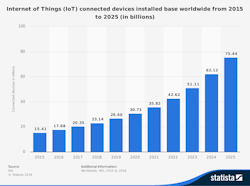By HENRY FRANC, Belden -- This time of year is always a good time for reflection – and anticipation of what’s to come. I’m no Punxsutawney Phil, and this blog isn’t by any means a typical Farmers’ Almanac, but it’s important to think about what’s happening in our industry – and how it will impact us all. So here’s my attempt at creating a forecast of what you can expect in the ICT space in 2019, especially from a cabling standards perspective.
What’s Driving Industry Change?
The biggest drivers of evolution and change in the ICT industry are the rise of M2M (machine to machine) communication and the IoT (Internet of Things). According to Statista, via IHS and Forbes, the number of connected devices doubled the Earth’s population a few years ago. In 2015, Statista estimated more than 15 billion devices worldwide, forecasting more than 23 billion by the time we read this article and more than 75 billion by 2025.
The evolution of converged networks: Why IoT is here to stay
Traditionally, cabling standards development – specifically when it comes to the ICT industry – has centered on the premise that most requirements are people to people (P2P) or people to machine (P2M) communications. We are well beyond that phase, fast entering the primacy of M2M, which will eclipse traditional P2x telecommunications in scale, scope and complexity. The activities of IEEE, TIA and other standards-developing organizations reflect that new reality.
The scale of this change is demonstrated by the graph below.
The scope is evident in our everyday discussions about smart buildings, smart tech, enabled everything, IoT and connected cities, communities and spaces. More aspects of our lives are becoming Internet enabled to enhance experiences, safety, efficiency and overall quality of life.
The growing exposure to connectivity is driving complexity. Network requirements vary wildly, from literally bytes of data (e.g. sensors and switches) to hundreds of gigabytes and beyond. Power over Ethernet (PoE) requirements are equally varied, from none at all to 100W powered devices. Connectivity ranges, whether wired or wireless, can also vary from a handful of meters to several kilometers.
Not that we ever did before, but we definitely do not live in – and cannot prepare – an ICT world of one size/media fits all. We’re seeing an increase in wireless technologies, such as 5G, 802.11ax and others, that, no matter what, still rely on wired infrastructure to enable portability and mobility. Joining the realm of traditional category cables will be new solutions to suit single-pair Ethernet (SPE) on the copper side. Fiber hasn’t been immune to change, either, with the introduction of OM5, increasing parallel optic opportunities and even the probability of optics on board in the near future.
How Cabling Standards Enable Industry Change
Standards development is leading and enabling the change. In the case of the application standards from organizations such as IEEE, and infrastructure standards from TIA, the volume and velocity of change is incredible. It’s important for all of us to be aware of what’s going on.
The IEEE Liaison Report to TIA’s TR-42 Engineering Committee, responsible for the premise and cabling standards that support ICT, is over 40 pages of just highlights, with dozens of active projects.
Remember when 40GBASE Ethernet seemed a stretch for multimode fiber a few years ago? 802.3cm is working on 400GBASE Ethernet. Or remember when GPON was a 1G or 10G play? Now they’re working on 25, 50 and 100 Gb/s networks (802.3ca). But it’s not all faster or farther.
Sometimes, networks need to be shorter, such as M2M or industrial networks; speeds can be slower or, rather, right sized to network requirements, whether it’s the 802.3ch group working on 1 Gb/s networks of ~10 m for the automotive industry, the 802.3cg group working on 10 Mb/s over 1 km for last-mile applications or a 100 Mb/s 4-hop topology for industrial (802.3bw).
3 choices for data center media types: Copper, fiber or nothing at all?
Even though some of these applications seem very targeted from a market perspective, expect to see significant creep (or innovation) as they move into other areas of our lives. Can you see any uses for a high-speed link over very short distances? Or a low-speed link over greater distances in commercial premises and others? I’m sure you can. So can I (and so can others). We are not alone – synergies and opportunities abound. They will drive more business solutions; the push of our technology to balance out the pull of business need.
TIA’s TR-42 Engineering Committee is keeping pace with this change. Not only are we constantly updating the cabling standards you’ve come to know and use every day, but we also continue to develop new guidance in the form of TSBs (technical service bulletins), addenda (to existing cabling standards) and new standards.
New standards are in development for the cabling required to support SPE. Within the TR-42.7 Copper Cabling Sub-Committee, work has started on ANSI/TIA-568.5, which will address the needs of single pair as well as an addendum to ANSI/TIA-568.2-D to address the component specifications for field-term plugs being used to support MPTLs (modular plug terminated links).
The fiber optic sub-committees of TR-42.11 and TR-42.12 published the data required to support OM5, as well as Base-16 optics, and have started work on a TSB to address tutorial/field requirements in regard to optical fiber channel polarity. The TR-42.9 Industrial Telecommunications Infrastructure Sub-Committee is working on SPE for industrial environments as an addendum to ANSI/TIA-1005-A.
Pathways, spaces, grounding/bonding and administration updates are occurring in the TR-42.3 Commercial Building Telecommunications Pathways and Spaces Sub-Committee, specifically in the areas of PoE and its impacts. The TR-42.1 Commercial Building Telecommunications Cabling Sub-Committee is also working on SPE topology hand in hand with the TR-42.7 group. Because we need not only hyperscale/cloud data centers, but also that functionality closer to the devices at the edge for the rain-and-mist aspects where latency and proximity can be significant considerations and requirements, they have started a task group focused on edge data centers.
Fundamentally, my prediction is this: The ICT landscape will be significantly different by this time next year, with a high likelihood of even more change in the next few years than we’ve had in the past.
With an emphasis on data center design, planning and building, HENRY FRANC acts as a trusted advisor for large or complex projects across all verticals, assessing clients’ business needs and finding the best technology options to meet them. He was also elected by industry colleagues to serve as vice-chair of the TR42 Telecommunications Cabling Systems Engineering Committee.


